

Mars will reach opposition on 29 January 2010.
The simulations on the right are from Calsky and show Mars as it was expected to be seen through a 10-inch telescope at the date and time indicated. These simulations are all on the same scale and do not reflect the changing apparent size of the planet as its distance from us changes. My images do reflect that change and can most easily be seen on my page for the 2005/6 season. I do not know what controls the orientation of the Calsky images, but I align my camera with the telescope which itself is aligned with the pole, so my images should all be the same way up, except that the the polar axis of Mars will appear to change somewhat during a season (it is tilted at 25° to the plane of the martian orbit).
(I have been unable to find any simulations by Mr. Ikemura whose simulations I have used previously.)
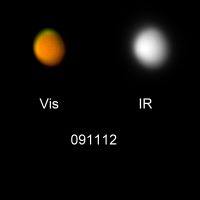
My first image of Mars for the new season. This picture was taken 1½ hours before sunrise with Mars at an altitude of 57° and 164 million km (1.09 AU) away when it subtended an angle of 8 seconds of arc. The planet was 89% illuminated (as seen from Earth), and the gibbous appearance is about all that can seen in the picture.
I admit to being rather disappointed with this picture until I downloaded the simulation from CalSky.com. This is what is sometimes called the "boring side" of Mars as there is little detail to be seen.
Date and Time: 10th November 2009 at 05:45 (vis) and 06:18 (IR) UT
Camera: ToUcam 840K (vis) and DMK 21 (IR)
Telescope: LX200 with X2 lens. The IR picture was taken using a commercial IR-pass filter (>652 nm)
Capture: K3CCDTools and IC Capture.
Visible image: Low gamma, high saturation, 1/50", 14% gain, 1046 frames.
IR image: Gamma 10, 1/13", gain 570, 1866 frames.
Processing: Registax.
Visible image: 180 frames stacked. Wavelets 1-2 = 10.
IR image: 190 frames stacked, histogram 0-235, wavelets 1-2 = 5.
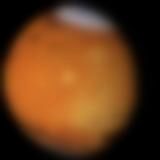
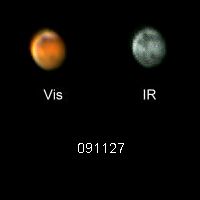
My second image of Mars for the new season, and much improved. Mars was at an altitude of 47° and 146 million km (0.975 AU) away and it subtended an angle of 9 seconds of arc. The planet was 90% illuminated (as seen from Earth).
The interval between this picture and the one above is 409.5 hours. Mars rotates in 24.623 hours so this interval corresponds to 16.63 solar days on Mars so here we see the other face of Mars which shows more detail. The pictures were taken 35 (vis) and 22 (IR) mins before sunrise, so the sky was getting quite bright. The colour of Mars looks right despite the blue from the sky; it was very bright by the time I took the IR image, but an IR filter removes the majority of the light scattered from the sky.
Date and Time: 27th November 2009 at 07:06 (vis) and 07:19 (IR) UT
Camera: ToUcam 840K
Telescope: LX200 with X2 lens. The IR picture was taken using my home-made IR-pass filter
Capture: K3CCDTools and IC Capture.
Visible image: Low gamma, high saturation, 1/25", 8% gain, 1033 frames.
IR image: Low gamma, B/W mode, 1/25", 8% gain, 312 frames.
Processing: Registax.
Visible image: 127 frames stacked. Wavelets 1-2 = 10, gamma 0.8, Focus Magic 6,50.
IR image: 92 frames stacked, wavelets 1-2 = 10, gamma 0.8, Focus Magic 6,50.
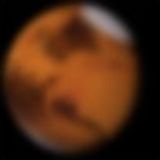
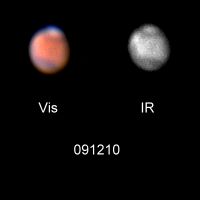
Mars is creaping closer but is still some way from opposition. Here it was 131 million km (0.877 AU) away and it subtended an angle of 10 seconds of arc. It was at an altitude of 46°, much lower than it will be at opposition.
Date and Time: 10th December 2009 at 06:35 (vis) and 06:42 (IR) UT
Camera: ToUcam 840K
Telescope: LX200 with X2 lens. The IR picture was taken using my home-made IR-pass filter
Capture: K3CCDTools.
Visible image: Low gamma, high saturation, 1/33", 7% gain, 1006 frames.
IR image: Low gamma, B/W mode, 1/25", 50% gain, 997 frames.
Processing: Registax.
Visible image: 162 frames stacked. Wavelets 1-3 = 10, histogram 0-235.
IR image: 107 frames stacked, wavelets 1-3 = 10, histogram 0-160.
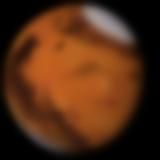
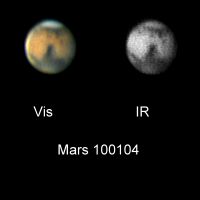
Mars is creaping closer to opposition. Here it was 108 million km (0.723 AU) away and it subtended an angle of 12 seconds of arc. It was at an altitude of 53° on a beautiful night. My best picture so far this season. The Syrtis Major (the dark pillar-shaped area in the southern hemisphere) is clearly evident, and the narrow feature to its left (west) is probrbly Mare Sirenum. To the north of Syrtis Major is Nilosyrtis protruding south from Umbra to its west and Utopia to it east. Have I caught a glimpse of Boreosyrtis? Mars is presenting much more of its northern hemisphere than has been the case in the last few years, bringing these northern features into view. The north polar cap is clearly visible. Compare these pictures with those I took in 2003 when the south polar cap was showing, and those in 2005 and 2007 when neither cap was particularly evident.
Date and Time: 4th January 2010 at 01:17 (vis) and 01:27 (IR) UT
Camera: ToUcam 840K
Telescope: LX200 with X2 lens. The IR picture was taken using my home-made IR-pass filter
Capture: K3CCDTools.
Visible image: Low gamma, high saturation, 1/33", 33% gain, 647 frames.
IR image: Low gamma, B/W mode, 1/25", 70% gain, 789 frames.
Processing: Registax.
Visible image: 199 frames stacked. Wavelets 1-2 = 10, histogram 0-165, gamma 0.8.
IR image: 107 frames stacked, wavelets 1-2 = 10, histogram 0-130, gamma 0.8.
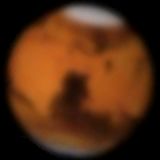
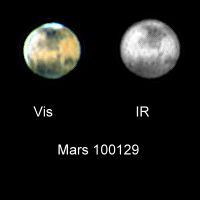
Mars at opposition. Here it was 99 million km (0.66 AU) away and it subtended an angle of 14 seconds of arc. It was at an altitude of 58°. Mars was at its closest that night so will now recede as the Earth overtakes it in its orbit. I am slightly disappointed at the quality of these pictures, but the Moon was full that night and only about 7° away and the skies not completely clear. The dark area in the north is the Niliacus Lacus with Xanthe extending to the west. The dark area in the south is Aurorea Sinus and the bright area to its north is called Chryse.
If you move your mouse over the image, you will see the same visible image (but moved to the right) alongside one taken 2 hours earlier. You can see how far the planet has rotated in the two hours (its period of rotation is 24½ hours).
Mars is approaching summer in the northern hemisphere and reaches the solstice on 13th May, so the north polar cap is shrinking. The seasons on Mars are almost twice as long as they are on Earth; the equinox was on 27th October, so the northern hemisphere is almost halfway through spring and we may expect to see the polar cap shrink even further over the next 3 months.
Date and Time: 29th January 2010 at 23:27 (vis) and 23:51 (IR) UT
Camera: ToUcam 840K
Telescope: LX200 with X2 lens. The IR picture was taken using my home-made IR-pass filter
Capture: K3CCDTools.
Visible image: Low gamma, high saturation, 1/50", 20% gain, 1215 frames.
IR image: Low gamma, B/W mode, 1/25", 27% gain, 1257 frames.
Processing: Registax.
Visible image: 193 frames stacked. Wavelets 1-2 = 10, histogram 0-165. Focus Magic 4,100
IR image: 231 frames stacked, wavelets 1-2 = 10, histogram 0-120. Focus Magic 4,100
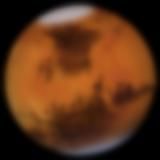
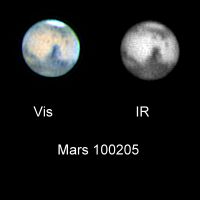
Mars a week later. 100 million km (0.67 AU) away and it subtending an angle of 13 seconds of arc, it was at an altitude of 51°. I am pleased with the quality of these pictures, especially as I nearly didn't take them. The skies were unexpectedly clear and I was planning to image a couple of DSOs, but there was Mars shining down from the south-east; it wouldn't take long....
The fainter colours compared to the last image are not significant. I captured these with automatic colour balance which I don't usually do. The north polar cap is clearly visible and the large dark feature in the centre of the disk is the Syrtis Major.
Date and Time: 5th February 2010 at 21:26 (vis) and 21:38 (IR) UT
Camera: ToUcam 840K
Telescope: LX200 with X2 lens. The IR picture was taken using my home-made IR-pass filter
Capture: K3CCDTools.
Visible image: Low gamma, high saturation, 1/33", 10% gain, 1205 frames.
IR image: Low gamma, B/W mode, 1/25", 55% gain, 894 frames.
Processing: Registax.
Visible image: 152 frames stacked. Wavelets 1-2 = 10, histogram 0-145. Focus Magic 3,100
IR image: 158 frames stacked, wavelets 1-2 = 10, histogram 0-140.
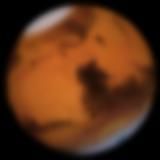
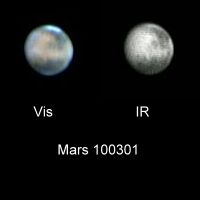
By the beginning of March Mars had receded to 116 million km (0.78 AU) away and it subtending an angle of 12 seconds of arc, it was at an altitude of 54°.
This is the first of three pictures I took during a single week, so the changing face of Mars will be apparent. The large dark area in the north is called the Niliacus Lacus.
Date and Time: 1st March 2010 at 19:54 (vis) and 20:25 (IR) UT
Camera: ToUcam 840K
Telescope: LX200 with X2 lens. The IR picture was taken using my home-made IR-pass filter
Capture: K3CCDTools.
Visible image: Low gamma, high saturation, 1/33", 22% gain, 1203 frames.
IR image: Low gamma, B/W mode, 1/25", 72% gain, 1665 frames.
Processing: Registax.
Visible image: 105 frames stacked. Wavelets 1-2 = 10, histogram 0-145.
IR image: 141 frames stacked, wavelets 1 = 10, 2 = 5, histogram 0-130.
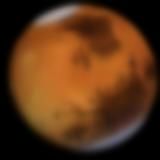
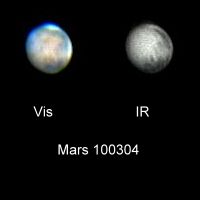
Three days later, Mars was 119 million km (0.80 AU) away and subtended an angle of 11 seconds of arc, it was at an altitude of 54°. The visible picture here was taken 75.7 hours after the one above and this represents a little over three martian days. You can see that the planet has rotated a little to the east (right). Niliacus Lacus has almost disappeared over the eastern limb.
Date and Time: 4th March 2010 at 23:34 (vis) and 23:25 (IR) UT
Camera: ToUcam 840K
Telescope: LX200 with X2 lens. The IR picture was taken using my home-made IR-pass filter
Capture: K3CCDTools.
Visible image: Low gamma, high saturation, 1/33", 18% gain, 1203 frames.
IR image: Low gamma, B/W mode, 1/25", 70% gain, 236 frames.
Processing: Registax.
Visible image: 107 frames stacked. Wavelets 1 = 10, 2 = 5, histogram 0-140.
IR image: 84 frames stacked, wavelets 1-2 = 10, histogram 5-145.
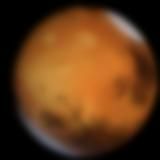
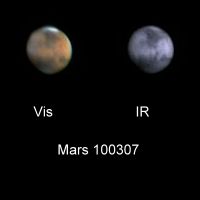
Three days later again. Mars was 122 million km (0.82 AU) away and it subtending an angle of 11 seconds of arc, it was at an altitude of 61°.
70 hours represents 2.84 Martian days. The features are slightly to the west (left) of their position in the picture two above. Niliacus Lacus has moved back to the centre of the disk.
Date and Time: 7th March 2010 at 21:37 (vis) and 21:45 (IR) UT
Camera: ToUcam 840K
Telescope: LX200 with X2 lens. The IR picture was taken using my home-made IR-pass filter
Capture: K3CCDTools.
Visible image: Low gamma, high saturation, 1/50", 20% gain, 931 frames.
IR image: Low gamma, 1/25", 39% gain, 912 frames.
Processing: Registax.
Visible image: 159 frames stacked. Wavelets 1-2 = 10, histogram 0-145.
IR image: 158 frames stacked, wavelets 1 = 10, 2 = 5, histogram 0-170.
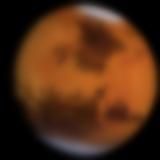
Home Back to Mars